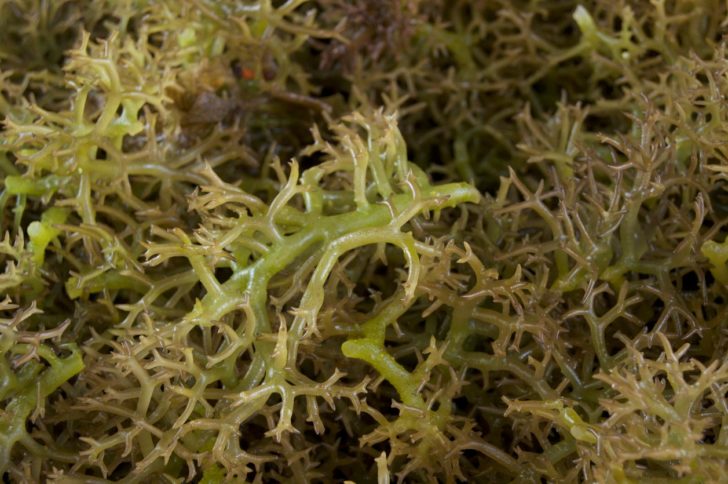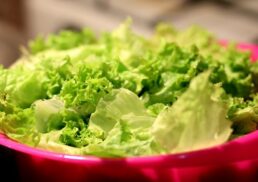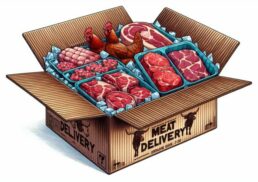You may have encountered the term “carrageenan” on the labels of various food items and wondered what exactly it is. Carrageenan, derived from carrageen seaweed, has been a staple in traditional Irish cuisine and medicine for centuries. Today, it is used as a food additive in a variety of products, from dairy to processed foods. In this blog post, we will unveil the mysteries of carrageen, exploring its rich history, role in the food industry, and potential health benefits.
Table of Contents
Key Takeaways
Carrageen, or Irish moss, has been used for centuries in Ireland for medicinal and culinary purposes.
It is now widely used as a vegan alternative to gelatin in the food industry as an emulsifier and stabilizer.
Carrageen plays an essential role in marine ecosystems with various conservation initiatives protecting it from overharvesting.
Carrageen: A Seaweed with a Rich History

Carrageen, also called Irish moss, is a common seaweed with a rich history tracing back to Ireland. Its traditional uses include remedies for respiratory ailments and culinary applications, such as carrageen moss pudding. Irish migrants brought carrageen to North America, where it gained recognition for its versatility in the food industry.
Nowadays, food-grade carrageenan finds its way into a diverse range of products, playing roles from helping to replace gelatin in vegan dessert recipes to a texture enhancer in dairy and meat products.
Origin and Name
The name “carrageen” is derived from the Irish word “carraigeen,” meaning “little rock,” inspired by Carrigan Head, a cape near Northern Ireland. It was initially used to describe seaweeds in general and later became associated with the Chondrus crispus species, also known as Irish moss.
This ubiquitous seaweed held a considerable role in Irish culinary practices and traditional medicine, underscoring its cultural and historical significance.
Traditional Uses
In Ireland, carrageen was traditionally used as a remedy for respiratory issues, such as sore throats and coughs. Irish doctors prescribed carrageen jelly or broth to alleviate chest problems and clear phlegm. Carrageen was also utilized in Irish cuisine, most notably in the making of carrageen moss pudding, a type of blancmange.
This adaptable seaweed has been a cherished part of Irish culinary practices for centuries and has found its way into other cultures over time.
Expansion to North America
Irish migrants escaping the devastating potato famines of the 18th and 19th centuries brought the use of carrageen, or Irish moss, to New England from Ireland. This is how the spread of carrageen originated. These migrants brought their knowledge of carrageen’s culinary and medicinal applications to the United States, where it gained recognition and continued to be utilized for its diverse properties.
Consequently, the cultivation of carrageen seaweed grew, cementing its position in the food industry and other sectors.
Carrageen’s Role in the Food Industry
Carrageenan, extracted from carrageen seaweed, is used extensively in the food industry as a vegan alternative to gelatin. This versatile food additive is derived from carbohydrate polymers found in red edible seaweeds and has numerous applications, particularly in dairy and meat products.
Due to its robust binding properties, carrageenan is a fundamental ingredient in an array of food products, spanning from ice cream to chocolate milk.
Replacing Gelatin
One of the most popular applications of carrageenan is as a vegan substitute for gelatin. Unlike gelatin, which is derived from animal collagen, carrageenan is plant-based and sourced from red seaweed. It has a higher melting point than gelatin, enabling it to withstand higher temperatures without losing its thickening properties.
As such, carrageenan is an apt choice for vegan and vegetarian diets and for anyone in search of natural food additives.
Applications in Dairy Products
Carrageenan is commonly used in dairy products as a stabilizer and emulsifier, improving texture, consistency, and mouthfeel. It is often found in:
Milk beverages
Yogurt
Ice cream
Other neutral dairy products
Carrageenan inhibits separation and preserves overall quality.
The ability of carrageenan to interact with proteins and boost emulsification performance adds value to dairy products.
Use in Processed Foods and Beverages
In addition to its applications in dairy products, carrageenan is used as a food additive in various processed foods and beverages. Its strong gelling, thickening, stabilizing, and water-binding abilities make it a popular choice for enhancing the texture and shelf life of food products. Carrageenan is found in items such as salad dressing, canned pet food, and plant-based beverages. However, using food-grade carrageenan in food applications is important, as specific forms could lead to adverse gastrointestinal effects.
Recognizing Carrageen in Nature

Carrageen is a small, branching seaweed with reddish-purple or greenish-yellow fronds. It is commonly found on rocky shores throughout the UK and other parts of the world. Recognizing carrageen in its natural environment is key for those intrigued by its culinary and medicinal uses, and for conservation strategies aimed at protecting this precious seaweed species.
Physical Characteristics
Carrageen is a thin, reddish-purple seaweed with branching fronds that may appear iridescent when submerged. It can turn green when exposed to intense light, and may even change color in response to exposure to varying environmental conditions. Carrageen does not possess air bladders, which distinguishes it from other seaweed species.
Its distinctive appearance and ability to change color render it an engaging and visually attractive organism in its natural surroundings.
Habitat and Distribution
Carrageen is commonly found in marine habitats with moderately strong or strong water flow, such as estuarine areas and rocky shores. It is abundant along the shores of Ireland, the coast of Europe, including Iceland and the Faroe Islands, and the western Baltic. Carrageen thrives in specific temperature, salinity, and nutrient conditions, and is cultivated in seaweed farms in the Philippines and Indonesia.
Acknowledging carrageen’s preferred habitat and distribution is key to preserving it and promoting its sustainable use.
Production and Types of Carrageenan
Carrageenan production involves farming and harvesting the seaweed in several countries, producing over 140,000 tons annually. There are three main types of carrageenan: lambda, iota, and kappa, each with different gelling and emulsifying properties.
Comprehending the production process and various types of carrageenan is key for individuals intrigued by its culinary, medicinal, and industrial uses.
Farming and Harvesting
Carrageenan production is a multi-step process that begins with the farming and harvesting of the seaweed. Cultivation typically takes place in countries such as the Philippines and Indonesia, which provide the necessary environmental conditions for the algae’ optimal growth. The harvested seaweed is then processed to extract the carrageenan, which is used in various food products and other applications.
Carrageenan farming and harvesting support the livelihoods of numerous communities and play an important part in satisfying the rising demand for this adaptable ingredient.
Refined vs. Semi-refined Carrageenan
Carrageenan can be produced as either refined or semi-refined, depending on the processing method used. Refined carrageenan is obtained by extracting the carrageenan from seaweed into an aqueous solution, while semi-refined carrageenan is produced by cooking the dried carrageen and seaweed in a hot alkali solution.
The decision between refined and semi-refined carrageenan hinges on the needed characteristics and applications, with both types boasting distinct properties and potential uses in the food industry.
Lambda, Iota, and Kappa Carrageenan
Lambda, iota, and kappa carrageenan are the three main types of carrageenan used in various applications. Here are their characteristics:
Lambda carrageenan is soluble and non-gelling, making it suitable for thickening and stabilizing solutions.
Iota carrageenan forms elastic, thermally reversible gels that do not display syneresis.
Kappa carrageenan forms firm, brittle gels in the presence of potassium salts.
Each carrageenan type provides unique properties and uses, enabling a myriad of applications in the food industry and other sectors.
Health Benefits and Nutritional Value
Carrageen is a source of dietary fiber, minerals, and vitamins, and may offer potential health benefits. Some studies suggest that carrageen consumption may reduce inflammation, support gut health, and improve blood sugar levels.
Nonetheless, more research is needed to fully comprehend the health benefits and nutritional value of carrageen.
Dietary Fiber
Carrageen is a good source of dietary fiber, with a content ranging from 0g to 60g per 100 grams, depending on the type. It is high in soluble fiber, which is known for its potential health benefits, such as promoting healthy digestion and reducing the risk of certain diseases.
Soluble fiber in carrageen can be fermented by gut bacteria in the colon, producing short-chain fatty acids that may offer additional benefits to the body, including reducing the risk of colon cancer.
Minerals and Vitamins
Carrageen contains various minerals and vitamins, including:
Calcium: essential for strong bones and teeth, muscle function, and nerve transmission
Magnesium: involved in numerous biochemical reactions in the body and contributes to muscle and nerve function, energy production, and maintaining a healthy immune system
Iodine: necessary for the production of thyroid hormones, which regulate metabolism and support healthy thyroid function.
The mineral and vitamin content of carrageen makes it a nutrient-dense addition to any diet.
Potential Health Benefits
Carrageen may offer the following health benefits:
Improved digestion
Immune support
Antioxidant properties
Anticancer properties
Antilipidemic properties
Anticoagulant properties
While some studies have suggested that carrageen consumption may be linked to harmful gastrointestinal effects such as inflammation and digestive disturbances, these effects were observed at levels far exceeding those of human consumption.
Carrageen is deemed safe for consumption in suitable quantities.
Debunking Carrageenan Safety Concerns
Research and expert opinions support the safety of carrageenan for consumption. The Joint FAO/WHO Expert Committee on Food Additives (JECFA) has deemed carrageenan safe for consumption, as have regulatory bodies such as the FDA and European Union.
Research indicates that carrageenan is safe for consumption at levels found in food products, and the prospective health benefits of carrageen may overshadow any potential hazards.
Research and Findings
Studies have shown that carrageenan is safe for consumption at levels found in food products. While some research has suggested that carrageen may be detrimental to human health, leading to bloating, inflammation, and digestive issues, these effects were observed at levels far exceeding those of human consumption.
Carrageen is typically viewed as safe when consumed in suitable quantities.
Expert Opinions and Regulatory Bodies
JECFA, the Joint FAO/WHO Expert Committee on Food Additives has conducted a thorough investigation into the safety of carrageenan for consumption. The committee concluded that carrageenan is safe to be consumed. This conclusion is based on studies conducted in rats, where any adverse effects due from carrageenan ingestion were observed at levels far exceeding those of human consumption.
The FDA and European Union also regulate carrageenan as a safe food additive. Customers can rest assured that carrageenan is safe for consumption in suitable quantities.
Carrageen in Everyday Life
Carrageen is used in various recipes, organic products, and DIY extracts. From traditional Irish puddings and desserts to skincare and supplements, carrageen offers a wide range of applications in everyday life. Its adaptability and potential health benefits render it a precious ingredient for those seeking to include natural ingredients in their diet and lifestyle.
Carrageen Pudding and Desserts
Carrageen is a popular ingredient in traditional Irish puddings and desserts, such as carrageen moss pudding. This gelatinous ingredient is derived from carrageen moss, a type of seaweed found along the Irish coast. It is used to create a set texture in desserts, similar in form to jellies and blancmanges.
Carrageen pudding is enjoyed in Ireland and other cultures, showcasing the versatility and appeal of this unique seaweed.
Carrageen-based Organic Products
Carrageen is used in various organic products, such as skincare and supplements. Its thickening, emulsifying, and stabilizing properties make it a valuable addition to these products, improving texture and preventing the separation of ingredients.
Carrageen-based organic products offer consumers an alternative to synthetic additives and are a testament to the versatility and potential benefits of this natural ingredient.
DIY Carrageen Extract
Carrageen can be used to make homemade extracts for culinary and cosmetic purposes. The process involves:
Harvesting the seaweed
Boiling it in water
Filtering
Introducing alcohol to separate the carrageenan
Pressing and dehydrating the carrageenan
Pulverizing it into a fine powder
DIY carrageen extract allows individuals to create their own natural ingredients for use in recipes and personal care products, showcasing the versatility and appeal of carrageen.
Environmental Impact and Conservation Efforts
Carrageen plays a role in marine ecosystems, and conservation initiatives aim to protect it. The Wildlife Trusts’ “Living Seas” vision, for example, seeks to cultivate a marine environment where marine wildlife can flourish.
Efforts to preserve carrageen and other seaweeds are vital for upholding marine biodiversity and ensuring the sustainable utilization of these precious resources.
Role in Marine Ecosystems
Carrageen is an important part of marine ecosystems, providing habitat and food for various species. Seaweeds, including carrageen, are essential for preserving marine biodiversity. They offer:
Refuge and sustenance to a variety of species
Protection against erosion
Oxygen production through photosynthesis
Filtration of water, improving water quality
Carrageen plays a crucial role in maintaining the health and balance of marine ecosystems.
Additionally, farming carrageen seaweed can benefit local ecosystems and enhance the overall biodiversity of the ocean.
Conservation Initiatives

Organizations like the Wildlife Trusts work towards protecting seaweeds like carrageen through their “Living Seas” vision. Other organizations, such as Sea PoWer, The Nature Conservancy, and Aqua-Farms, strive to empower women, provide livelihoods, and promote sustainable farming practices for seaweed conservation. Additionally, the Food and Agriculture Organization plays a role in promoting sustainable practices in the global agriculture sector.
These initiatives strive to protect the wellbeing of marine ecosystems and ensure the sustainable utilization of carrageen and other valuable seaweed species.
Summary
In conclusion, carrageen is a versatile and valuable seaweed with a rich history and a wide range of applications in the food industry, health, and everyday life. Its potential health benefits, environmental impact, and conservation efforts highlight the importance of this unique seaweed species. By understanding the various aspects of carrageen, we can appreciate its role in our lives and work towards ensuring its sustainable use and conservation for future generations.
Frequently Asked Questions
What is carrageenan and why is it bad for you?
Carrageenan is a food additive derived from seaweed extract and has been linked to digestive issues, inflammation, and potential colon cancer. Scientists have accepted that degraded carrageenan, or poligeenan, can pose serious health risks. Removing this additive from your diet may be beneficial.
Why is carrageenan not banned?
Despite concerns over potential adverse human health effects, regulatory agencies and research organizations around the world have consistently concluded that carrageenan is a safe and highly functional food additive. The food industry is also against banning it, as it is an important ingredient for making organic foods palatable.
What is carrageen moss good for?
Carrageen Moss is beneficial for treating infections and respiratory ailments such as bronchitis, pneumonia and sore throat, due to its antimicrobial, antitumor and antiviral agents. It can also absorb and expel excess fluids from the body.
Is carrageen the same as carrageenan?
Yes, carrageen is the same as carrageenan – the latter name is derived from a species of seaweed known as Carrageen Moss or Irish Moss.
Where is carrageenan found?
Carrageenan is an edible red seaweed extract commonly used as a thickening and gelling agent in the food industry, found in many products such as nut and soy milks, deli meats, protein shakes and powders, chocolate milk, yogurt, popsicles, prepared meals, ice cream and infant formula.









